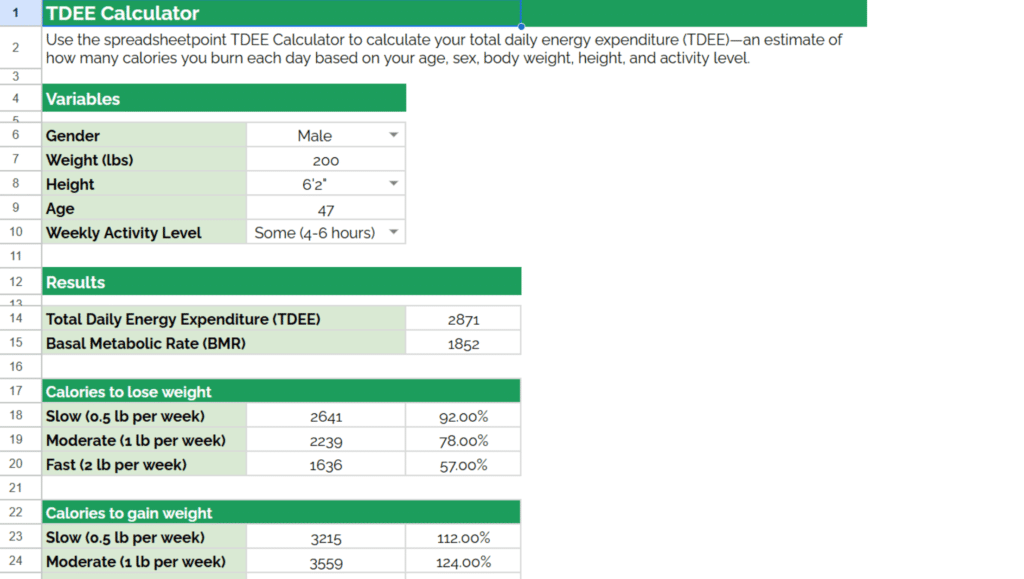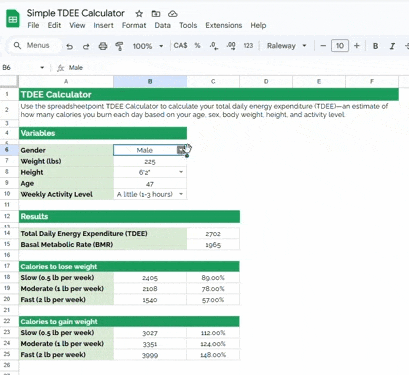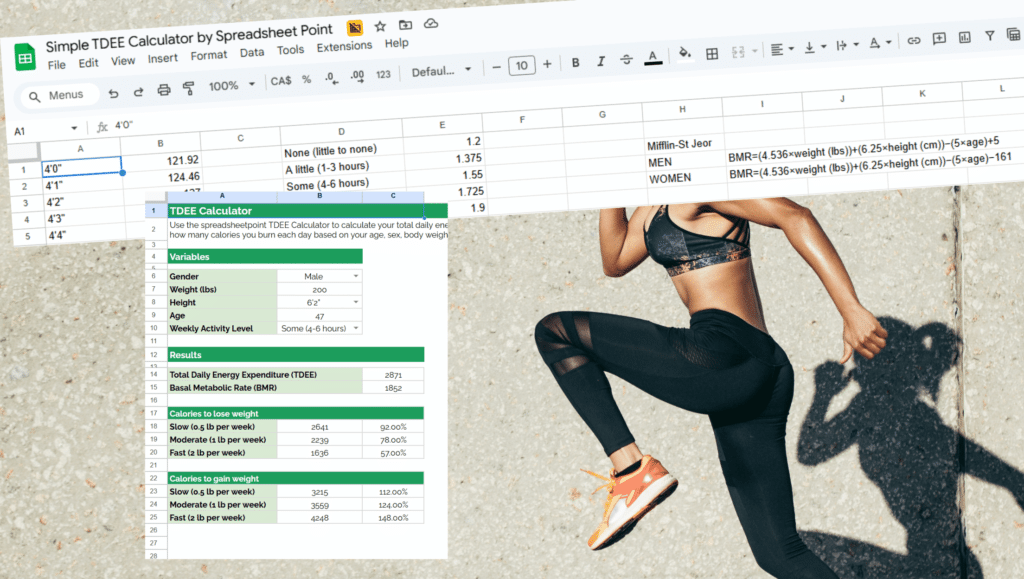If you are serious about losing weight, gaining muscle, or maintaining your current physique, one of the most important numbers you can calculate is your TDEE, or Total Daily Energy Expenditure. This single figure tells you exactly how many calories your body burns in a day, combining both your resting metabolism and your activity level. Once you know your TDEE, you can set realistic calorie goals that match your fitness journey.

In this guide, we will explain what TDEE is, show you how it works for weight loss, and walk you through building your own calculator in Google Sheets. And if you want to save time, we have created a free TDEE calculator spreadsheet template you can copy instantly to start tracking today.
Access the template and make your own copy.
What is TDEE?
If you are trying to lose weight, gain muscle, or simply maintain your current body weight, one of the most important numbers you can understand is your TDEE, or Total Daily Energy Expenditure.
TDEE is the amount of calories your body burns in a day when you factor in both your Basal Metabolic Rate (BMR) and your physical activity.
- BMR is the number of calories your body needs at rest to keep your organs functioning. Think of it as the energy your body uses even if you stayed in bed all day.
- Activity energy includes everything else: walking, working out, cleaning the house, even small movements like fidgeting.
When you add these together, you get your TDEE.
Why is this number so important? Because knowing your TDEE gives you a benchmark. If you want to lose weight, you need to eat fewer daily calories than your TDEE. If you want to gain muscle or put on weight, you need to eat more calories than your TDEE. If you want to maintain your current body weight, eating about the same as your TDEE will keep you steady.
In other words, your TDEE is the key number that determines whether you will lose, gain, or maintain weight over time. It’s valuable information for anyone interested in monitoring their caloric intake. Pair it with a weight loss spreadsheet, and you can track it all right from your desktop or phone.
Can I Use TDEE to Lose Weight?
The short answer is yes. In fact, TDEE is one of the most effective ways to guide your weight loss. It’s needed if you want to reduce body fat or maintain more lean body mass. And it is an asset for anyone who wants more control over their eating habits.
Let’s break it down with a simple example.
Imagine your TDEE is 2,400 calories per day. That means if you eat 2,400 calories, your weight should stay the same.
- If you eat 2,100 calories per day, you will be in a 300-calorie deficit. Over the course of a week, that adds up to 2,100 calories fewer than your body needs. Over time, that deficit forces your body to burn stored fat.
- If you eat 1,900 calories per day, you are in a 500-calorie deficit. That’s 3,500 calories in a week, which is roughly equal to one pound of fat loss.
- A surplass diet might be 2,500 or 2,800 calories per day.
This is why so many trainers, dietitians, and athletes use TDEE to set their calorie goals. It is flexible, it works with any diet style, and it can be adjusted to your lifestyle and as your body changes.
A word of caution: You should not drop your calories too low. Extreme deficits can slow your metabolism, cause nutrient deficiencies, and leave you feeling drained. A moderate deficit of 300 to 500 calories below your TDEE is enough for sustainable fat loss. And you should always talk to your doctor if you have aggressive weight loss goals.
How to Build a TDEE Calculator (Free!)
There are many online TDEE calculators available, but you can also build one yourself in Google Sheets for free. This is not only easy to set up, but it also gives you complete control. You can update your data whenever you want, and you will have a clear record of your progress.
Here is a step-by-step guide to building your own TDEE calculator in Google Sheets:
Step 1: Gather the formulas you need
TDEE is based on BMR plus activity. One of the most common ways to calculate BMR is with the Mifflin-St Jeor Equation. It breaks down the metabolic rate by gender.
- For men: BMR = 10 × weight (kg) + 6.25 × height (cm) – 5 × age (years) + 5
- For women: BMR = 10 × weight (kg) + 6.25 × height (cm) – 5 × age (years) – 161
And note that this isn’t the only method. It’s just the one we like best. You can also use the Harris-Benedict equation or the Katch-Mcardle equation (which can be better for higher muscle mass).
Whichever you choose, you’ll just need to decide before you add it to your spreadsheet. Once you have it, multiply your BMR by your activity multiplier:
- Sedentary (little or no exercise): × 1.2
- Lightly active (light exercise/sports 1–3 days/week): × 1.375
- Moderately active (moderate exercise 3–5 days/week): × 1.55
- Very active (hard exercise 6–7 days/week): × 1.725
- Extra active (physical job or twice-daily training): × 1.9
This gives you your TDEE estimation.

Step 2: Set up your spreadsheet
When we build our TDEE spreadsheet, we added all the personal data next. That includes an option to choose gender, current weight (in pounds), height, age, and weekly activity level. All of this is important for the formula. It calculates the total number of calories recommended for slow, moderate, and fast weight loss or weight gain.
- Open a new Google Sheet.
- Create columns for Weight (kg), Height (cm), Age (years), Sex (M/F), and Activity Level.
- In the next cell, create the formula for BMR using the Mifflin-St Jeor Equation. You can use an IF formula to account for male and female differences.
- Multiply the BMR result by the activity multiplier.
For example:
=IF(B2="M", (10*C2 + 6.25*D2 – 5*E2 + 5), (10*C2 + 6.25*D2 – 5*E2 – 161)) * F2
Where:
- B2 = Sex
- C2 = Weight
- D2 = Height
- E2 = Age
- F2 = Activity Multiplier
You can copy/paste the formula above to output your TDEE.
Step 3: Add charts and tracking
Once you have your TDEE, you can set up tables and charts to track your actual calorie intake, your target intake, and your progress over time. Google Sheets makes this simple with built-in charts.
You can create one sheet that calculates your TDEE and another sheet that logs your daily weight and calorie intake. Over time, you will see how closely your real results line up with the numbers.

Again, you can make a copy of our TDEE calculator for free, then open the second tab to see all the calculation information in one place.
Tracking daily activities with a workout spreadsheet? You can connect both of them to display all of your data in one place. It’s easy to create a dashboard in Google Sheets.
Our Free TDEE Calculator Spreadsheet Template
If you do not want to build your own, we have done the work for you. We created a free TDEE calculator template in Google Sheets that you can access right away.
This template includes:
- A BMR calculator using the Mifflin-St Jeor equation
- Automatic TDEE calculation based on your activity level
- A table for entering your daily or weekly weight
- A chart that compares your target weight against your actual weight
- Adjustable axis settings so you can see your progress clearly
You only need to enter your numbers, and the spreadsheet will handle the rest.
This tool makes it easy to calculate, track, and adjust your TDEE without relying on third-party apps or subscriptions. All you need is Google Sheets, and you can copy the template to your account for free.
It’s an asset for sustainable weight loss. And it’s the best TDEE calculator for Google Sheets.
On The Thermic Effect of Food
When calculating your TDEE, one important factor is the Thermic Effect of Food (TEF). This refers to the energy your body uses to digest, absorb, and process the food you eat. In simple terms, not all calories are the same once they are in your body.
Each macronutrient has a different thermic effect:
- Protein: About 20 to 30 percent of protein calories are burned during digestion. If you eat 100 calories of protein, only about 70 to 80 calories are left for your body to use.
- Carbohydrates: Around 5 to 10 percent of carbohydrate calories are burned during digestion.
- Fat: The lowest thermic effect, at about 0 to 3 percent.
On average, TEF makes up about 10 percent of your total daily energy expenditure. If your TDEE is 2,500 calories, about 250 calories are used simply to break down and process food.
This explains why diets that include more protein often feel more filling and can support weight management. Protein not only helps you feel satisfied, but it also increases the number of calories your body burns each day.
And if you’re focused on muscle growth, your daily calorie intake is only a part of the equation. Protein like beef or chicken is valuable for more strenuous exercise, even beyond regular activities.
Why Use a Spreadsheet Instead of an App?
There are many fitness apps that claim to calculate TDEE and track calories. However, a spreadsheet gives you flexibility and transparency that apps rarely offer.
- Full control: You can see the formulas yourself and make changes if you like.
- Customization: Add your own data points, charts, or notes.
- Free forever: Unlike paid apps, Google Sheets is free to use.
- No hidden paywalls: Your spreadsheet will never ask you to upgrade.
For many people, this is the simplest and most effective way to manage their calorie goals. That said, we love MyFitnessPal. It helps people track calories for each meal, and it has a nice graph that shows weight gain or loss over time.
Final Thoughts
TDEE is one of the most important numbers in any weight management journey. It tells you how many calories you burn in a day and gives you the foundation to make smart decisions about eating and exercise.
By calculating your TDEE and using a spreadsheet to track your progress, you put yourself in control. You can aim for a realistic calorie deficit if your goal is fat loss, or eat slightly above your TDEE if you want to build muscle.
With our free Google Sheets template, you can calculate your TDEE, log your weight, and chart your progress without needing complicated software.
Take a few minutes today to grab the template and set up your numbers. Your future self will thank you.